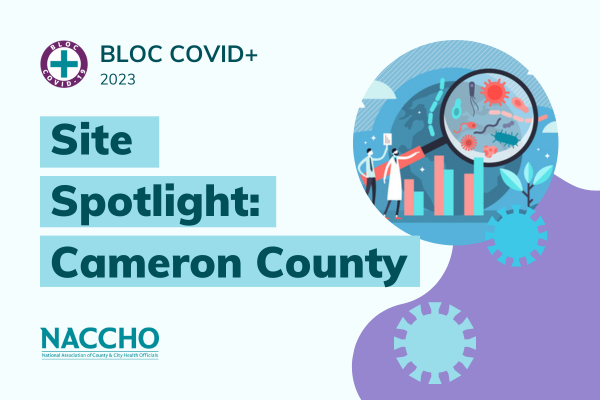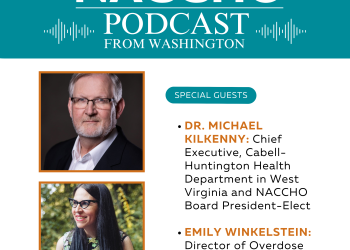The Building Local Operational Capacity for COVID-19, Healthcare-Associated Infections, and Antimicrobial Resistance (BLOC COVID-19+) project continues and expands upon the first year of the BLOC COVID-19 Demonstration Site project by allowing LHDs to go beyond COVID-19 response and address other HAIs and AR pathogens.
The goals of the BLOC COVID-19 + project are to:
- Strengthen relationships between LHDs and facilities and partners;
- Enhance LHD capacity and confidence in assessing and supporting infection prevention and control (IPC) practices in high-risk facilities;
- Improve implementation of IPC in high-risk facilities; and
- Decrease rates of and negative outcomes associated with COVID-19, HAIs, and AR pathogens in those facilities.
We asked our BLOC COVID+ sites to reflect on their experiences and lessons learned since joining our project. Here is what one of our sites, Cameron County, shared with us. A standalone version of their blog post can be viewed here.
From Cooperation to Collaboration: Lessons Learned from an Local Health Department
“In the early months of 2022, Cameron County Public Health (CCPH) was selected as a BLOC COVID-19+ demonstration site by the National Association of County and City Health Officials (NACCHO), which focuses on upscaling local capacity to go beyond the COVID-19 response and address healthcare associated infections (HAI) and antimicrobial resistant (AR) pathogens.
Located in the southernmost tip of Texas in the Rio Grande Valley, Cameron County is home to over half a million residents. With a largely binational and impoverished populace facing historic health disparities, the surge in demand for short and long-term acute care due to COVID-19 exposed glaring gaps in residents’ healthcare access. In 2020, carbapenem-resistant Enterobacteriaceae (CRE) and multidrug-resistant Acinetobacter (MDRA) were among the top five notifiable conditions for Cameron County; consequently, HAIs and AR pathogens were placed at the top of the list of disease prioritization in later years. As such, the goal of our team as a BLOC COVID-19+ demonstration site was to increase Cameron County Public Health’s capacity to prevent and respond to the evolving threat of HAIs and AR pathogens through bolstering education and outreach efforts with local long-term care facilities (LTCFs), including skilled nursing facilities (SNFs) and assisted living facilities (ALFs).”
Lesson 1: Approach Through a Lens of Support
“Prior to the project, CCPH was primarily viewed as a local health department reporting entity, whereby LTCFs and hospitals are required by state law to report COVID-19 and other notifiable conditions. From March 2020 to January 2021, LTCFs would work with our department to provide linelists for outbreaks required by our investigations; however, one of our goals with the project was to build an active network for facilities to voice concerns and receive education about infection control (IC) efforts. Through the grant, LTCFs opened their doors to receive ICARs and educational trainings in infection control. We approached each LTCF as an opportunity to strengthen and support their infection control efforts, and continuously emphasized that our involvement was not regulatory. While some LTCFs were hesitant at first, we made sure to leave a lasting and cordial impression during our onsite visits, often praising them for the work they were doing, encouraging questions during the ICARs, and offering constructive criticism and incentives for their participation, including Glo Germ kits and respiratory etiquette signs for posting.”
Lesson 2: Strengthen Internal Capabilities
“A primary activity our team focused on was enhancing facility reporting and capturing data in meaningful ways. One of the major ways we prioritized this goal was by checking-in with our LTCFs regularly about the status of any outbreaks, updating case reports and linelists for reporting to the state, and by switching to an electronic fax line, which aided in effective outbreak management by reducing time spent reading through forms and maintaining electronic data. Separate linelists were maintained for LTCF COVID-19 reports, which allowed us to quickly and accurately examine relevant trends.”
Lesson 3: Work With What You’ve Got
“In our workplan, we identified key personnel to hire for the project in order to enhance internal capacity and expertise —namely, a Public Health Nurse. Although this position was filled, it became vacant within a month, leaving our department with only one HAI epidemiologist for the project team. Rather than throwing in the towel, we opted to shift our focus and look into utilizing existing staff for our efforts. Our sole HAI epidemiologist worked with the regional state epidemiologists (Texas DSHS Region 11) to lead the clinical and non-clinical aspects of ICARs. Our HAI epidemiologist also took responsibility to interface with the Director of Nursing and Infection Preventionist at the LTCFs as the primary contact, providing guidance and recommendations for infection control. Other epidemiologists within the LHD also assisted the HAI epidemiologist by providing feedback on disseminating educational material and shadowing during ICARs.”
Lesson 4: Leverage Partnerships with Subject Matter Experts
“Ultimately, much of the guidance and education given to our LTCFs would not have been possible without the help of the Texas DSHS Region 11 HAI epidemiologists. Not only did they allow us to shadow multiple proactive and response driven ICARs in person and virtually, but they also allowed us to lead and assist in writing the summary reports for multiple ICARs. Prior to the project, our LHD worked with the Region 11 HAI team to report significant HAI/AR incidents and clusters, while also receiving guidance on surveillance priorities. While this relationship is a valuable resource for solving novel questions in an evolving field, allowing us to lead ICARs both in-person and virtually allowed our team to expand our independent response capabilities with effectiveness and confidence.
Overall, our site has been able to expand its capabilities and operations through the BLOC COVID-19+ Project by prioritizing HAIs and AR pathogens in long term acute care hospitals and skilled nursing facilities alike. The resources and experience gained has been invaluable to our team, and has allowed us to move forward with creating action plans and internal guidebooks for future IC teams that will remain sustainable well beyond the project term.”



